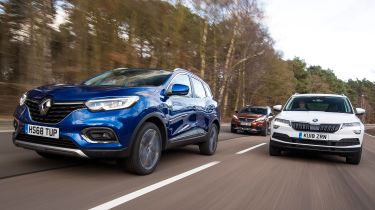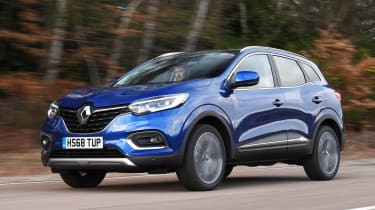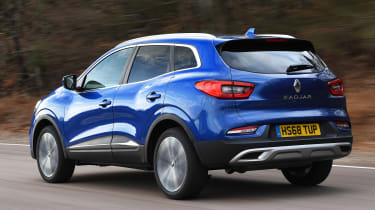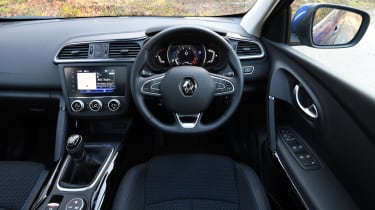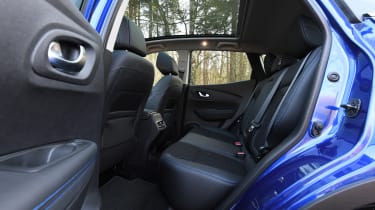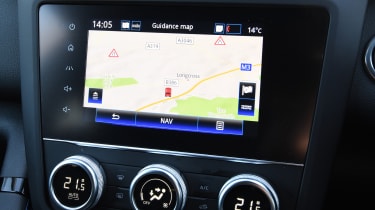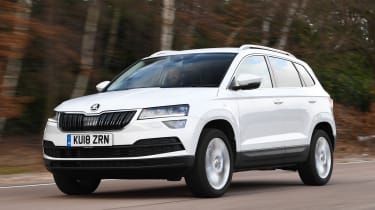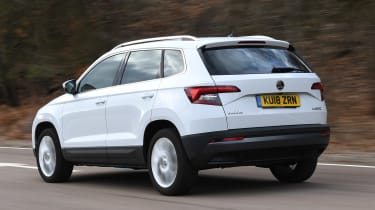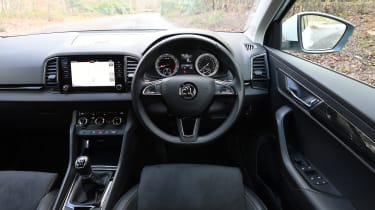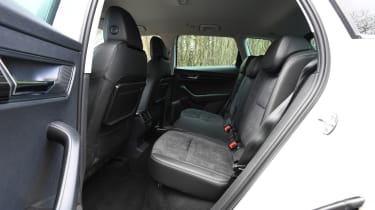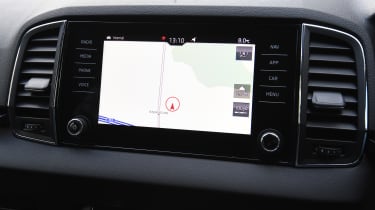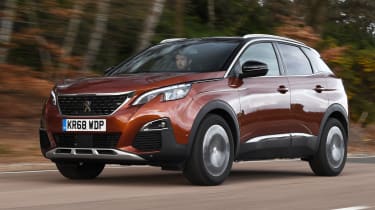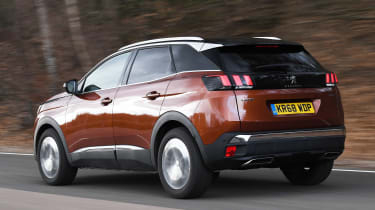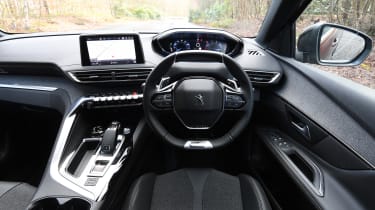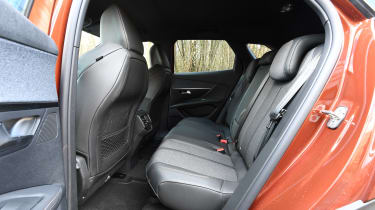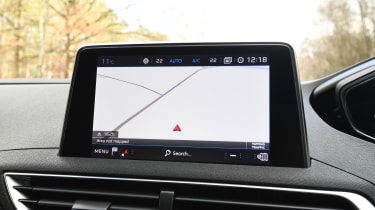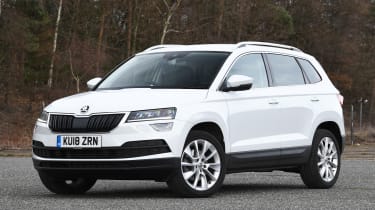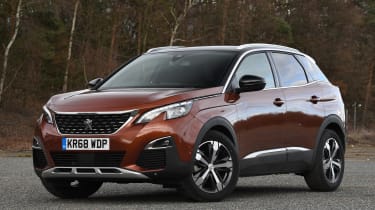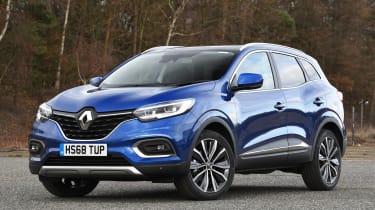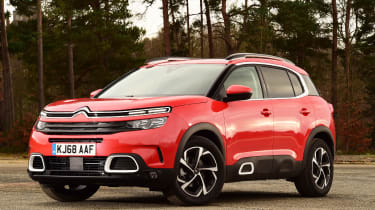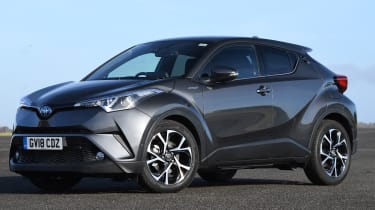Renault Kadjar vs Skoda Karoq vs Peugeot 3008
Refreshed Renault Kadjar takes on the class-leading Skoda Karoq and popular Peugeot 3008 in family SUV showdown
The mid-size SUV sector is one of the most competitive in the business, and new models are always on the way to replace or revamp. This is, after all, a very popular type of car in 2019 and manufacturers are striving to meet the demands of more and more customers.
This time, it’s Renault that is hoping to take over the top spot in the class with its latest update for the Kadjar. When it arrived in 2015 this model rose to the head of its market segment.
But in the years since, the French family SUV has been overtaken by rival cars from Skoda and Peugeot. So if the facelifted Renault Kadjar wants to keep up with the competition, it needs to stand up to a close comparison with the Skoda Karoq, our current favourite car in this class, and the Peugeot 3008, another key rival that was a convincing class leader when it launched.
Both of these competitors offer an impressive mix of practicality, style, comfort and efficiency. Here we’ll take a closer look at each model in order to find out which has the best blend of abilities and, of course, which represents top value for money.
Renault Kadjar
| Model: | Renault Kadjar TCe 140 S Edition |
| Price: | £23,595 |
| Engine: | 1.3-litre 4cyl petrol, 138bhp |
| 0-60mph: | 9.9 seconds |
| Test economy: | 33.9mpg/7.5mpl |
| CO2: | 136g/km |
| Annual road tax: | £140 |
The Renault Kadjar has been updated with fresh engines and a subtle new look. We’re testing the big-selling £23,595 TCe 140 S Edition.
Design & engineering
The Kadjar’s new engine is the main change with this refresh, because in the years since the car was launched, buyers have switched from mainly diesel to petrol power. That’s why we’re focusing on the new 138bhp 1.3-litre turbo petrol unit, although Renault has also updated its diesel engine range, which will be of interest to buyers who still do higher mileages.
Used - available now

2021 Ford
EcoSport
12,435 milesManualPetrol1.0L
Cash £13,902
2022 Ford
EcoSport
20,987 milesManualPetrol1.0L
Cash £12,813
2019 Ford
Fiesta Vignale
11,775 milesAutomaticPetrol1.0L
Cash £15,004
2021 Toyota
Yaris Cross
37,716 milesAutomaticPetrol1.5L
Cash £20,279The facelift involves new bumpers front and rear, along with LED lights at the back, but the exterior changes are pretty minor overall.
It still sits on the Renault-Nissan CMF platform, which is shared with one of its close rivals, the Nissan Qashqai. This has also seen updates to its engine range recently. The Kadjar uses pseudo-MacPherson struts at the front and a torsion beam at the rear, which is a typical set-up for this kind of vehicle.
On the inside, the update has added redesigned seats, a new armrest and cup-holders, plus new air-conditioning controls and, on our S Edition car, a seven-inch touchscreen infotainment display.
The screen includes DAB radio, Bluetooth, Android Auto and Apple CarPlay as standard, and S Edition trim also features 19-inch alloys, LED headlights, synthetic leather upholstery, keyless operation, front and rear parking sensors and a reversing camera.
Interior quality is good, if not quite up to the standard of its rivals here. The cabin doesn’t have the material quality or visual flair of the Peugeot, or the solid feel or user-friendly design of the Skoda. There are some neat touches, such as the climate controls with small displays within the dials, and the seats are comfortable, but ultimately the Renault falls behind its two test opponents in this category.
Driving
When it comes to the driving experience, however, the Kadjar is competitive. For a start, it’s comfortable, partly thanks to the seats and partly to the well-engineered suspension set-up.
It sits in between its rivals here, although all three cars are pretty closely matched. The Renault remains composed and soft over small imperfections, while movements caused by larger potholes are well controlled. While the 3008 is just as good on most roads, it tends to crash into bigger bumps, where the Renault doesn’t. The Skoda is the best of the three models, remaining neatly controlled on rough roads; still, the Kadjar isn’t far off the Czech model.
Its new 1.3-litre engine is also strong, offering a good level of refinement. While it’s very quiet at low revs, the Kadjar suffers slightly from road and wind noise at higher speeds, although the engine remains quiet – even if you rev it hard it’s still smooth.
However, the Renault’s motor doesn’t relish being pushed particularly, so it’s just as well that there’s plenty of punch in the mid-range, which keeps things nice and relaxed.
The Skoda’s 1.5-litre petrol unit is nearly as quiet and the 3008’s engine is also great in a different way, because its three-cylinder thrum makes it a more characterful motor when on the road.
The Kadjar took 9.9 seconds to go from 0-60mph in our tests, which was in between the 9.2 and 10.6 seconds the Skoda and Peugeot recorded respectively. That doesn’t tell the whole story, though, because the Renault proved to be relatively brawny during our in-gear tests. It was quicker than both of its rivals from 30-50mph in third and fourth gears, as well as from 50-70mph in fifth and sixth.
Practicality
Space is obviously very important in a family SUV, so it’s unfortunate that the Renault has the smallest boot of the three cars here, at 472 litres. The Skoda’s variable boot is larger, at 479 litres in its smallest configuration, and it has a more uniform shape, while the 3008 boasts a versatile load bay, at 520 litres in total.
But the difference in size is not so big that you would be at a disadvantage day-to-day opting for the Renault – the revamped French SUV is still spacious and more than big enough for a family car inside.
There’s an adequate amount of leg and headroom in the rear, while it’s a bit lighter inside than the 3008 and the seats aren’t as bulky, which means it’s slightly roomier. But both fall behind the Karoq here; this car has the most room and feels the brightest in the back.
Ownership
In the makers’ chart of our Driver Power 2018 owner satisfaction survey, Renault finished in 24th position out of 26 brands, which was a poor result and some way behind Skoda, which ranked sixth, and 17th-placed Peugeot.
The Kadjar also falls behind for safety kit, because autonomous braking, which is a core safety feature in 2019, is missing, yet is fitted as standard on both rivals. However, you do get lane-keep assist, which is optional on the Karoq and standard on the 3008, but blind spot warning isn’t available on the Renault.
Running costs
That lack of AEB pushes up insurance costs, because the Kadjar sits in the highest group of the three and will cost our example driver £492 a year in premiums, while the Skoda’s quote was £376 and the Peugeot’s was £418.
The 3008 was the most economical car on test, returning 43.7mpg, while the Renault managed 33.9mpg and the Skoda 38.9mpg. As a result of this, the Kadjar will cost the most at the pumps each year, at £1,931. Fuel bills for the Skoda and Peugeot come to £1,683 and £1,498 respectively.
Testers’ notes: “As with most models in this class, the Kadjar is no driver’s car. The steering is lifeless and there’s moderate body roll in corners, so the Renault suits a more relaxed style from behind the wheel.”
Skoda Karoq
| Model: | Skoda Karoq 1.5 TSI 150 SE L |
| Price: | £25,660 |
| Engine: | 1.5-litre 4cyl petrol, 148bhp |
| 0-60mph: | 9.2 seconds |
| Test economy: | 38.9mpg/8.6mpl |
| CO2: | 124g/km |
| Annual road tax: | £140 |
The Skoda Karoq is our favourite mid-size SUV, so it’s the car the Kadjar will need to beat if it is to take victory here. We’re testing the Czech model in SE L form powered by Skoda’s 148bhp 1.5-litre TSI petrol engine, which costs £25,660.
Design & engineering
Just like both of its rivals, the Karoq is built using a widely used platform; in this case it’s the Volkswagen Group’s MQB set-up, which is shared with cars such as the VW Golf plus other SUVs, like the SEAT Ateca.
The 1.5-litre petrol engine is the most powerful in this test, producing 148bhp at 5,000rpm and 250Nm of torque from just 1,500rpm – 10Nm more than the Renault and 20Nm ahead of the Peugeot – partly thanks to it having a slightly larger capacity than rival engines. Yet the bigger engine didn’t use more fuel than the Kadjar’s during our test, so it appears there’s little penalty for the extra power.
As with its rivals, the Karoq uses MacPherson struts at the front with a torsion beam at the back. Adaptive dampers are offered for £1,000. It’s not necessary to add this option, because the set-up is well judged for British roads in passive form, although it’s good to know that it’s available.
The Skoda’s interior is a close second to the 3008’s here – the French car’s cabin is superb. Yet the Karoq’s neat, pragmatic design is elegant and more pleasing than the Kadjar’s slightly muddled-looking dash.
SE L trim features an eight-inch touchscreen infotainment system with sat-nav, Apple CarPlay and Android Auto. Parking sensors, a reversing camera, autonomous braking, heated seats, adaptive cruise control, keyless go and LED headlights are also fitted, while material quality is the best in the test.
Driving
Having a more powerful engine meant that the Skoda was not surprisingly the quickest car from 0-60mph. It took just 9.2 seconds, 0.7 seconds ahead of the Kadjar and beating the 3008 by 1.4 seconds.
However, longer gearing ensured the Karoq fell behind its competitors in our in-gear tests, because its 4.6-second time from 30-50mph was slower than both rivals’. Still, in sixth it took 11 seconds flat to go from 50-70mph, only 0.2 seconds behind the Renault and 1.4 seconds ahead of the Peugeot.
There’s enough performance, though, because the Skoda’s 250Nm of torque is delivered low in the rev range, so you can keep revs down and change up early if you prefer, but the engine is still happy to be pushed.
The gearchange is by far the best of the three cars as well. While it has a light shift action, it’s precise and has a mechanical feel, in contrast to the rubbery, disconnected feel you get from the French models.
That gearbox precision is matched by the Karoq’s well-weighted steering, which is one of the reasons why the Skoda is the best driver’s car of this trio. It’s well controlled and doesn’t suffer with body roll too much, yet the slightly firmer suspension set-up isn’t uncomfortable. It doesn’t crash into potholes like the 3008, although you’ll notice smaller bumps more.
The Czech SUV has the best ride and handling balance, too, satisfying in both areas. The well-judged steering also makes the Karoq easy to drive; when combined with good forward visibility, it’s easy to place on the road and doesn’t feel as large as its rivals from behind the wheel, despite being the same width as the 3008 and a little wider than the Kadjar.
Practicality
Our SE L Karoq features ‘Varioflex’ rear seating, so the 60:40-split bench slides backwards and forwards to prioritise either load capacity or passenger legroom.
Even with the seats set back for maximum passenger space, the Karoq has more room in the boot than the Kadjar; there’s 472 litres in the Renault, while the Skoda has from 479 to 588 litres in the back, depending on set-up. The 3008 falls in between our challengers, with a fixed 520-litre capacity. All three load bays are more than big enough for a few large suitcases, but the Skoda’s versatility is welcome.
It’s also more spacious in the back than the French duo, with lots of legroom and a taller roofline for extra headroom. Cabin storage is good, too, and the neatly laid-out interior means it’s easy to live with.
Ownership
Skoda has been a strong performer in our Driver Power satisfaction surveys for years, and in 2018 it was sixth out of 26 firms in the makers’ chart, well ahead of Renault in 24th and Peugeot in 17th. The brand also finished eighth in the dealers’ poll, while Peugeot was 17th and Renault 27th out of 28, so the Karoq ownership experience is likely to be better.
All three models scored five stars in their Euro NCAP crash tests, and the Skoda offers autonomous braking, pedestrian detection and adaptive cruise control as standard. You can also add blind spot monitoring and lane-keep assist for £860, although these safety features are included on the 3008.
Running costs
With CO2 emissions of 124g/km, the Karoq should be cheap to run, especially if you’re choosing one as a company car. It sits in the same 25 per cent Benefit-in-Kind (BiK) tax bracket as the 120g/km Peugeot, yet because it has a lower list price, the Skoda will cost higher-rate earners £2,544 a year, next to the 3008’s £2,616.
The Renault emits 136g/km of CO2 and sits in the 28 per cent BiK bracket, so it will set a top-rate taxpayer back £2,614 in tax contributions. Again, it’s the higher price that pushes up its company car tax, although nobody is going to be too concerned by a £2 difference between the two figures.
Testers’ notes: “A total boot space of 1,605 litres means the Skoda has the most room inside if you fold all the seats down. The Renault and Peugeot offer 1,478 and 1,482 litres respectively.”
Peugeot 3008
| Model: | Peugeot 3008 PureTech 130 Allure |
| Price: | £26,375 |
| Engine: | 1.2-litre 3cyl petrol, 129bhp |
| 0-60mph: | 10.6 seconds |
| Test economy: | 43.7mpg/9.6mpl |
| CO2: | 120g/km |
| Annual road tax: | £140 |
The 3008 is Peugeot’s best SUV, so it’s a strong competitor in this class. We’re testing an Allure model (our pictures show a GT Line) to match the Renault and Skoda’s specs, and it costs £26,375 with the PureTech 130 petrol engine in manual form.
Design & engineering
As with its competitors in this group test, the 3008 uses a versatile platform in its construction, with the Peugeot based on the French firm’s EMP2 architecture. It uses MacPherson struts at the front and a torsion beam rear axle, the same as its rivals.
Yet the 3008 differs from them with its engine, because the 1.2-litre unit is a three-cylinder rather than the four-cylinder motors in the Renault and Skoda. It’s the least powerful engine, with 129bhp on tap, yet its torque figure of 230Nm is only 10Nm behind the Renault’s output. Also, outright power is less important in these cars, which focus more on comfort and practicality, while the 3008 is also the lightest of the three models, at 1,320kg.
Where the 3008 really shines is with its interior, which is one of the best in its class. Material quality is mixed, with some cheaper plastics dotted around, but in the places that you come into contact with most frequently, it’s great. The textile that runs across the dash and into the doors is a lovely touch.
Peugeot’s second-generation i-Cockpit set-up is much improved and means there’s a twin-screen layout in all models, with a 12.3-inch digital display in front of the driver and an eight-inch dashboard-mounted touchscreen. The i-Cockpit design features a small steering wheel, so while the driving position isn’t ideal, it works better in the higher 3008 than it does, for example, in the 308 hatchback, which has the first generation of the maker’s system.
The Peugeot is a little more expensive than its rivals here, but along with the twin screens, the 3008 has sat-nav, Android Auto and Apple CarPlay, climate control, cruise control and a reversing camera.
Driving
On most roads the 3008 is comfortable, because it irons out smaller imperfections well. It’s a solid performer on the motorway, too, and the engine remains pretty quiet at a cruise, which ensures the Peugeot is relatively refined.
But the suspension doesn’t cope with bigger bumps as well as its rivals. The 3008 tends to crash into larger potholes, where the Kadjar and Karoq take them in their stride better. The Peugeot’s soft suspension also introduces some body roll when cornering that isn’t present in the Skoda, in particular, which reduces confidence on country roads. The small steering wheel doesn’t help with that, either, because while the rack is fairly quick, the chassis feels less controlled as you turn the wheel.
It’s something you get used to, however, but ultimately the 3008 isn’t as good to drive as the Karoq. It does feel more alert than the Kadjar, but the Renault’s steering is more natural.
The 3008 is best driven in a more relaxed way, then, but whatever your style behind the wheel, it does still suffer from a vague gearshift. At least the engine is good fun, though, with an entertaining note and punchy performance.
The Peugeot matched the Skoda from 30-50mph in fourth gear at 6.1 seconds, yet both were beaten by the Renault’s 5.3-second time. In fifth, the 3008 took 8.3 seconds to go from 50-70mph, only 0.1 seconds behind the Kadjar and 0.4 seconds ahead of the Karoq. This means that in the real world, the 3008 feels just as quick as both rivals, while it also offers good flexibility despite its less powerful engine.
Practicality
Access to the Peugeot’s rear seats is a little more compromised than in its competitors due to a lower roof, but it’s not too much of an issue. Less space in the rear, partly due to the big front seats, is, though. Still, there’s enough leg and headroom, and while it’s as roomy as the Renault, it’s obviously smaller than the Skoda.
Storage is okay, with some big cubbies and a large central bin. It can feel a bit snug in the front seats because of this, but there’s still plenty of room. Its 520-litre boot is close to the Skoda’s variable load bay, while it easily eclipses what the Kadjar offers in terms of load space and, therefore, practicality.
Ownership
Peugeot scored consistently in our Driver Power 2018 poll, ranking 17th in the manufacturer and dealers’ sections. That was ahead of Renault, but way behind Skoda.
At least the 3008 has a five-star Euro NCAP rating, and boasts more safety kit than its rivals, because blind spot warning is standard, along with lane-keep assist, autonomous braking, parking sensors and a reversing camera. You’ll have to pay an additional £860 to match that specification in the Skoda, and AEB isn’t even an option on the Kadjar – you have to move up to a more expensive version to get that.
Running costs
Our depreciation experts predict a residual value of 47.2 per cent for the Peugeot, which means it’ll lose £13,926 and be worth £12,449 after three years and 36,000 miles.
The Karoq is estimated to retain 51.3 per cent, dropping £12,486 to a value of £13,174 in that time. The Renault has the lowest expected residual value, at 43.6 per cent, yet because it’s initially cheaper to buy, it loses less than the Peugeot (£13,319). It’s set to be worth £10,276 after three years.
On test, the 3008 returned 43.7mpg, the best figure here, and well ahead of the Kadjar’s 33.9mpg. This makes up for its higher price and monthly PCP costs.
Testers’ notes: “Rearward visibility can be a bit of an issue in the 3008, along with the slightly awkward driving position. However, some buyers will be happy to put up with that for the car’s sharp styling.”
Verdict
First place: Skoda Karoq
It’s another victory for the Karoq, because it’s still the best all-rounder in this class. It rides smoothly, yet is also the most enjoyable car to drive. The sliding seats mean it has the most boot space, but also plenty of rear legroom, while the standard infotainment system is excellent. It’s great value, too, with all the kit you really need included. Running costs are kept low by the efficient engine and strong residuals.
Second place: Peugeot 3008
The 3008 still wows with its high-quality interior and hi-tech infotainment, which is standard on every car in the range. It’s not a one-trick pony, either, because the Peugeot is comfortable, spacious and cheap to run. It loses out here because its ride is less consistent than the Skoda’s, it’s more expensive and the interior is a bit more cramped. It’s not by much, though, and the 3008 is still one of the best cars in this class.
Third place: Renault Kadjar
Thanks to its new engine, the Kadjar is now even more competitive in this sector. It’s quiet, smooth and delivers solid performance, yet the ride is also smoother over bumps than the 3008’s. It’s well priced, but the equipment spec can’t match rivals’, and the interior isn’t as upmarket as theirs, either. It’s third place for the Renault, but the facelift was still a success in many ways.
Also consider…
Citroen C5 Aircross
Model: Citroen C5 Aircross PureTech 130 FlairPrice: £25,325Engine: 1.2-litre 3cyl, 129bhp
Citroen’s new C5 Aircross has the same platform and engines as the 3008, but with its own typically French styling inside and out. It has a soft ride and is well equipped, but isn’t as good to drive as its rivals, although it has an even bigger boot than the Skoda.
Toyota C-HR
Model: Toyota C-HR 1.2 ExcelPrice: £25,600Engine: 1.2-litre 4cyl, 113bhp
If you prefer the Japanese approach to family SUVs, the Toyota C-HR is a fine choice. It’s great to drive and rides smoothly, too, plus it’s well equipped. However, it’s quite cramped in the back and the engine isn’t as powerful as rivals’ motors.
| Skoda Karoq 1.5 TSI 150 SE L | Peugeot 3008 PureTech 130 Allure | Renault Kadjar TCe 140 S Edition | |
| On the road price/total as tested | £25,660/£28,200 | £26,375/£26,375 | £23,595/£24,395 |
| Residual value (after 3yrs/36,000) | £13,174/51.3% | £12,449/47.2% | £10,276/43.6% |
| Depreciation | £12,486 | £13,926 | £13,319 |
| Annual tax liability std/higher rate | £1,272/£2,544 | £1,308/£2,616 | £1,307/£2,614 |
| Annual fuel cost (12k/20k miles) | £1,683/£2,805 | £1,498/£2,497 | £1,931/£3,218 |
| Insurance group/quote/road tax cost | 15/£376/£140 | 16/£418/£140 | 19/£492/£140 |
| Servicing costs | £342 (2 years) | £425 (3 years) | £299 (3 years) |
| Length/wheelbase | 4,382/2,638mm | 4,447/2,675mm | 4,449/2,646mm |
| Height/width | 1,603/1,841mm | 1,624/1,841mm | 1,613/1,836mm |
| Engine | 4cyl in-line/1,498cc | 3cyl in-line/1,199cc | 4cyl in-line/1,333cc |
| Peak power/revs | 148/5,000 bhp/rpm | 129/5,500 bhp/rpm | 138/5,000 bhp/rpm |
| Peak torque/revs | 250/1,500 Nm/rpm | 230/1,750 Nm/rpm | 240/1,600 Nm/rpm |
| Transmission | 6-speed man/fwd | 6-speed man/fwd | 6-speed man/fwd |
| Fuel tank capacity/spare wheel | 50 litres/£150 | 53 litres/space saver | 55 litres/£150 |
| Boot capacity (seats up/down) | 479-588/1,605 litres | 520/1,482 litres | 472/1,478 litres |
| Kerbweight/payload/towing weight | 1,373/537/1,400kg | 1,320/590/1,400kg | 1,333/556/1,500kg |
| Turning circle | 10.2 metres | 10.7 metres | 10.7 metres |
| Basic warranty (miles)/recovery | 3yrs (60,000)/3yrs | 3yrs (60,000)/1yr | 3yrs (60,000)/3yrs |
| Driver Power manufacturer/dealer pos. | 6th/8th | 17th/17th | 24th/27th |
| NCAP: Adult/child/ped./assist/stars | 93/79/73/58/5 | 86/85/67/58/5 | 89/81/74/71/5 |
| 0-60/30-70mph | 9.2/12.2 secs | 10.6/9.9 secs | 9.9/9.1 secs |
| 30-50mph in 3rd/4th | 4.6/6.1 secs | 4.1/6.1 secs | 3.7/5.3 secs |
| 50-70mph in 5th/6th | 8.7/11.0 secs | 8.3/12.4 secs | 8.2/10.8 secs |
| Top speed/rpm at 70mph | 126mph/2,250rpm | 117mph/2,500rpm | 126mph/2,400rpm |
| Braking 70-0/60-0/30-0mph | 48.0/35.0/9.1m | 45.2/33.6/10.2m | 48.2/35.0/9.7m |
| Noise outside/idle/30/70mph | 72/43/61/70dB | 68/52/60/71dB | 63/42/65/73dB |
| Auto Express econ. (mpg/mpl)/range | 38.9/8.6/428 miles | 43.7/9.6/509 miles | 33.9/7.5/410 miles |
| WLTP combined mpg | 37.7-40.9mpg | 38.8-44.2mpg | 42.2-44.1mpg |
| WLTP combined mpl | 8.3-9.0mpl | 8.5-9.7mpl | 9.3-9.7mpl |
| Actual/claimed CO2/tax bracket | 168/124g/km/25% | 149/120g/km/25% | 193/136g/km/28% |
| Airbags/Isofix/park sensors/camera | Seven/yes/yes/yes | Six/yes/yes/yes | Six/yes/yes/yes |
| Auto box/lane-keep/blind spot/AEB | £1,030/£860*/£860*/yes | £1,600/yes/yes/yes | £1,500/yes/no/no |
| Clim/cruise ctrl/leather/heated seats | Yes/yes/£250/yes | Yes/y/£1,490/£560 | Yes/yes/synthetic/no |
| Metallic/LEDs/keyless go/pwr tailgate | £595/yes/yes/£500 | £575/£850/£350/£750 | £580/yes/yes/no |
| Nav/digi dash/DAB/connected apps | Yes/£450/yes/yes | Yes/yes/yes/yes | Yes/yes/yes/yes |
| Wireless charge/CarPlay/Android Auto | No/yes/yes | £120/yes/yes | £180/yes/yes |
